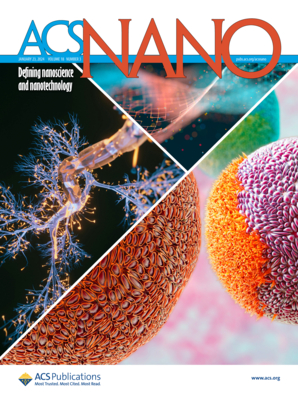Collagenase Degradable Biomimetic Nanocages Attenuate Porphyromonas gingivalis Mediated Neurocognitive Dysfunction via Targeted Intracerebral Antimicrobial Photothermal and Gas Therapy
IF 15.8
1区 材料科学
Q1 CHEMISTRY, MULTIDISCIPLINARY
引用次数: 0
Abstract
Porphyromonas gingivalis (P.g.), a pathogen linked to periodontitis, is reported to be associated with severe neurocognitive dysfunction. However, there are few reports focusing on improving neurological function in the brain by eliminating P.g.. Therefore, we developed a core–shell nanocomposite for targeted intracerebral P.g. clearance and ameliorating neurocognitive impairments, Pt-Au@C-P.g.-MM, consisting of platinum nanoparticles (Pt NPs) encapsulated within Au nanocages (Pt–Au) as the core and a shell made of collagen and macrophage membranes from macrophage pretreated with P.g. (C-P.g.-MM). This design enhanced the nanocomposite’s ability to cross the blood–brain barrier (BBB) and specifically target intracerebral P.g. through coating of P.g.-MM. Pt-Au@C-P.g.-MM depended on collagen to neutralize excessive collagenase from P.g., promoting its directed migration toward P.g.. Au nanocages exhibited excellent photothermal effects under near-infrared (NIR) laser irradiation, while Pt NPs also provided an efficient antibacterial gas therapy by generating oxygen to expose anaerobic P.g.. As a result, Pt-Au@C-P.g.-MM contributed to a synergistic antibacterial therapy and significantly reduced P.g. mediated neurocognitive dysfunction in periodontitis mice induced by oral P.g. infection. Based on the insights provided by the transcriptome sequencing analysis, anti-P.g. activity of Pt-Au@C-P.g.-MM facilitated the transition of microglia from the M1 to M2 phenotype by stimulating the PI3K-Akt pathway and reducing neuronal damage through the Wnt/β-catenin pathway.

胶原酶可降解仿生纳米笼通过靶向脑内抗菌光热和气体治疗减轻牙龈卟啉单胞菌介导的神经认知功能障碍
牙龈卟啉单胞菌(p.g.),一种与牙周炎相关的病原体,据报道与严重的神经认知功能障碍有关。然而,很少有报道关注通过消除p.g.来改善大脑的神经功能。因此,我们开发了一种核-壳纳米复合材料,用于靶向脑内P.g.清除和改善神经认知障碍,Pt-Au@C-P.g.-MM,由包裹在金纳米笼(Pt -Au)内的铂纳米颗粒(Pt NPs)作为核心,以及由胶原蛋白和巨噬细胞膜制成的外壳组成,这些巨噬细胞膜来自经P.g.预处理的巨噬细胞(C-P.g.-MM)。这种设计增强了纳米复合材料通过血脑屏障(BBB)的能力,并通过包裹P.g.- mm特异性靶向脑内P.g.。Pt-Au@C-P.g.-MM依赖胶原蛋白来中和p.g.过多的胶原酶,促进其向p.g.定向迁移。金纳米笼在近红外(NIR)激光照射下表现出优异的光热效应,而铂纳米笼也通过产生氧气暴露厌氧P.g提供了有效的抗菌气体治疗。因此,Pt-Au@C-P.g.-MM有助于协同抗菌治疗,并显着减少口腔P.g.感染引起的牙周炎小鼠P.g.介导的神经认知功能障碍。基于转录组测序分析提供的见解,anti- pg。Pt-Au@C-P.g.-MM的活性通过刺激PI3K-Akt通路和通过Wnt/β-catenin通路减少神经元损伤,促进小胶质细胞从M1表型向M2表型转变。
本文章由计算机程序翻译,如有差异,请以英文原文为准。
求助全文
约1分钟内获得全文
求助全文
来源期刊

ACS Nano
工程技术-材料科学:综合
CiteScore
26.00
自引率
4.10%
发文量
1627
审稿时长
1.7 months
期刊介绍:
ACS Nano, published monthly, serves as an international forum for comprehensive articles on nanoscience and nanotechnology research at the intersections of chemistry, biology, materials science, physics, and engineering. The journal fosters communication among scientists in these communities, facilitating collaboration, new research opportunities, and advancements through discoveries. ACS Nano covers synthesis, assembly, characterization, theory, and simulation of nanostructures, nanobiotechnology, nanofabrication, methods and tools for nanoscience and nanotechnology, and self- and directed-assembly. Alongside original research articles, it offers thorough reviews, perspectives on cutting-edge research, and discussions envisioning the future of nanoscience and nanotechnology.
 求助内容:
求助内容: 应助结果提醒方式:
应助结果提醒方式:


